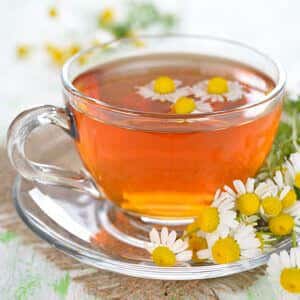
Two different plants carry the common name chamomile. One of them, M. chamomilla, is sometimes referred to as Hungarian, German, or genuine chamomile to distinguish it from C. nobile, Roman or English chamomile.
The older terminology for C. nobile is Anthemis nobilis. These very popular herbs are used almost interchangeably. Their chemistry is somewhat different, however.
Chamomile has a long-standing reputation as being good for almost anything that might ail a body.
Millions of children have learned about one of its most widespread uses, treating indigestion due to dietary indiscretion, from Beatrix Potter’s The Tale of Peter Rabbit.
Chamomile has small, white daisylike flowers with a yellow center. The flower is the part of the herb that is used.
Active Ingredients
M. chamomilla: German chamomile flowers contain about 0.5 percent of a volatile oil that is light blue. The most important constituents of the oil are bisabolol and related compounds and matricin.
Bisabolol has significant antispasmodic and anti-inflammatory activity.
Up to half of the oil is chamazulene, formed from matricin during heating.
Flavonoids in the flowers, apigenin and luteolin, are also active. In addition, the coumarins herniarin and umbelliferone may also quell inflammation and quiet smooth muscle spasms.
No single ingredient has been identified as responsible for the benefits of chamomile.
C. nobile: Roman chamomile flowers contain from 0.5 to 2.5 percent essential oil, which does not contain bisabolol.
The flavonoid ingredients are similar, though not identical, to those of M. chamomilla.
Uses of Chamomile
Both types of chamomile have traditionally been used in tea to treat digestive distress including stomachache, cramps, colitis, and flatulence.
Several of the constituents, bisabolol, for example, show antispasmodic activity in the test tube. In animal experiments, bisabolol also protects the stomach against ulcers caused by alcohol or indomethacin (a potent arthritis drug that often causes ulcers).
Another traditional use has been to relieve menstrual cramps.
Chamomile infusions are also used to stimulate the appetite and to aid digestion.
Chamomile tea is considered a mild sleep aid. In one study, it was effective in helping 80 percent of the patients awaiting cardiac catheterization get to sleep.
It is also used as a gentle treatment for fevers. Bisabolol can reduce fever in rats.
The essential oils are not very soluble in water; as a result, the dose of active ingredients delivered in the usual cup of chamomile tea is low.
Dr. Norman Farnsworth of the University of Illinois has suggested, however, that regular use of chamomile tea over an extended period has cumulative benefits.
Chamomile preparations are also used topically for red, inflamed skin and as a mouthwash or gargle. Components of this plant have antibacterial and antifungal activity.
Both bisabolol and the flavonoids are nearly as active as indomethacin in reducing inflammation in animal tests. Bisabolol helps burns heal faster under experimental conditions.
People with colds sometimes breathe in the vapors from a steaming cup of chamomile tea. This pleasantly aromatic steam is believed to help relieve congestion of the nose and lungs, at least for a short time unless you develop allergies or other symptoms.
Chamomile Dose
To make the tea, pour approximately 2/3 cup boiling water over 1 or 2 teaspoons dried chamomile flowers and steep at least five minutes.
For digestive problems, drink tea three to four times a day, between meals. There are no limitations on duration of use.
Special Precautions
Chamomile, like feverfew, belongs to the family of asters. Anyone allergic to ragweed, chrysanthemums, or other flowers in the family should probably avoid use of this herb as a sensible precaution.
Allergic reactions have been reported, characterized by abdominal cramps, hives, tongue thickness, swelling of the lips and throat, or difficulty breathing.
Chamomile should not be used to wash out the eyes or the area immediately around the eyes.
Adverse Effects
Ingesting large amounts of dried chamomile flowers can cause vomiting.
Possible Interactions
Interactions have not been reported.
There is a theoretical possibility, however, that taking another medication at the same time as chamomile tea could delay absorption of the other drug.
No interactions with the anticoagulant Coumadin have been reported, but in theory the coumarins in chamomile might potentiate this drug’s effect. Careful monitoring of bleeding time (through PT and INR) are recommended if chamomile is to be used together with Coumadin.

